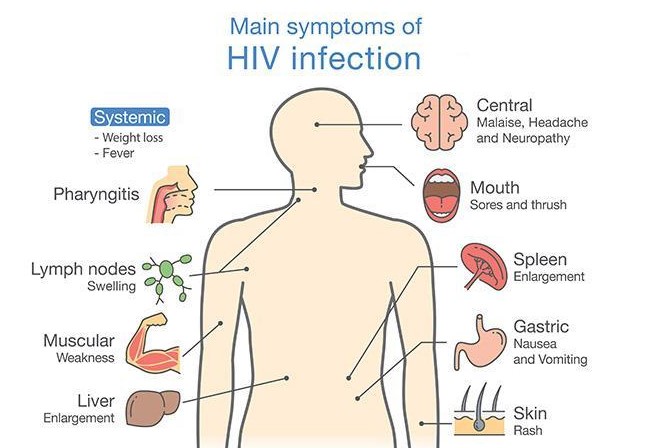BOURSESSENEGAL – Understanding how to identify an HIV rash can be crucial for early detection and treatment of the virus. HIV can cause a range of symptoms, and rashes are among the common indicators. This guide will help you recognize the characteristics of an HIV rash, show you what it looks like through pictures, and provide insights into other symptoms to watch for. Let’s delve into this important topic.
What is an HIV Rash?
Understanding HIV and Its Symptoms
HIV, or Human Immunodeficiency Virus, attacks the immune system. It can lead to Acquired Immunodeficiency Syndrome (AIDS) if untreated. While many people may not experience symptoms in the early stages, some do develop a rash. Recognizing this rash can be a key step in identifying the virus.
What Does an HIV Rash Look Like?
An HIV rash typically appears as red or brown spots on the skin. It can manifest as flat patches or raised bumps, often accompanied by other symptoms. The appearance of the rash varies from person to person, making it essential to pay attention to other indicators.
Types of Rashes Associated with HIV
1. Erythematous Rash
This rash presents as red or inflamed patches on the skin. It often feels itchy and can occur on various parts of the body.
Characteristics of Erythematous Rash
- Color: Bright red or pink.
- Location: Commonly found on the torso, arms, and legs.
- Texture: Flat or slightly raised.
2. Maculopapular Rash
A maculopapular rash consists of both flat and raised bumps. It often resembles other skin conditions, making it essential to consult a healthcare provider for proper diagnosis.
Key Features of Maculopapular Rash
- Color: Red or brownish.
- Location: Can appear on the face, chest, and back.
- Texture: Combination of flat and raised areas.
3. Seborrheic Dermatitis
While not exclusive to HIV, seborrheic dermatitis can be more common in those with weakened immune systems. This rash usually appears as scaly patches on the scalp or face.
Recognizing Seborrheic Dermatitis
- Color: Yellowish or brownish scales.
- Location: Scalp, face, and upper body.
- Texture: Flaky and oily.
How to Identify an HIV Rash: Step-by-Step Guide
Step 1: Observe the Color and Texture
When looking at a potential HIV rash, first note the color. Is it red, brown, or perhaps darker? Next, feel the texture. Is it smooth, raised, or scaly?
Step 2: Check the Location
Pay attention to where the rash appears. HIV rashes commonly show up on the torso, arms, and legs. If you notice a rash in these areas, take a photo for reference.
Step 3: Monitor for Additional Symptoms
An HIV rash rarely appears in isolation. Look for other symptoms such as:
- Fever
- Fatigue
- Swollen lymph nodes
- Sore throat
If you experience a rash along with these symptoms, it’s essential to seek medical advice.
Visual Identification: How to Use Pictures
Using Pictures for Comparison
When learning how to identify an HIV rash, using pictures can be incredibly helpful. Look for reputable medical sources that provide images of different types of rashes. Compare these pictures with your observations.
Where to Find Reliable Pictures
- Medical Websites: Trusted sites like the CDC or WHO offer accurate images.
- Healthcare Provider Resources: Many doctors provide educational materials that include photos.
- Books and Journals: Dermatology textbooks often have detailed images for reference.
Documenting Your Findings
Taking your own pictures can help you track changes. Ensure good lighting and clarity in your photos. If you notice any worsening or additional symptoms, share these images with your healthcare provider.
Other Common Symptoms to Watch For
1. Fever and Chills
Fever often accompanies an HIV rash, especially in the early stages. Monitor your temperature regularly. If you experience chills along with a rash, it’s a sign to consult a doctor.
2. Fatigue
Extreme tiredness can also indicate HIV. If you find that you’re more fatigued than usual without explanation, take note of this symptom.
3. Swollen Lymph Nodes
Lymph nodes may swell, particularly in the neck, armpits, or groin. This symptom often occurs with a rash and should not be ignored.
When to Seek Medical Attention
Recognizing Emergency Symptoms
If you experience any severe symptoms along with the rash, such as:
- Difficulty breathing
- Severe swelling
- High fever
Seek emergency medical attention immediately. These could be signs of a more serious reaction or another underlying condition.
Scheduling a Doctor’s Visit
If you notice a rash that resembles the descriptions provided here, schedule a visit with your healthcare provider. Bring along your documentation and any relevant pictures to assist in diagnosis.
Prevention and Management
1. Regular Testing
If you are at risk for HIV, regular testing is essential. Knowing your status can help you take appropriate action.
2. Safe Practices
Engage in safe practices, such as using condoms and avoiding sharing needles, to reduce the risk of HIV transmission.
3. Healthy Lifestyle Choices
Maintaining a healthy lifestyle can strengthen your immune system. Focus on a balanced diet, regular exercise, and sufficient sleep.
Conclusion: Stay Informed and Vigilant
Learning how to identify HIV rash pictures is a critical step in recognizing potential symptoms of HIV. Understanding the characteristics, types, and associated symptoms can help you take proactive measures.
Remember, early detection is key to effective treatment. If you suspect you have an HIV rash or experience related symptoms, don’t hesitate to consult a healthcare provider. Your health is paramount, and being informed can make all the difference. Stay vigilant, and take charge of your well-being!
how to identify hiv rash pictures
REFERENCE : mpo308



